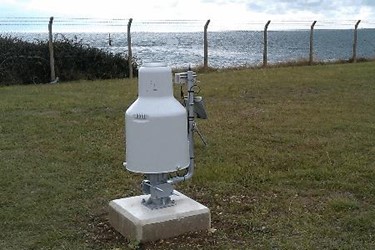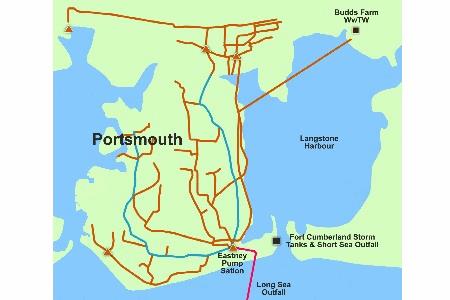‘Smart' Flood Alleviation System Protects Portsmouth

In late 2014, Southern Water completed a major project to reduce the risk of sewer flooding in parts of Portsmouth and Southsea. Substantial works were undertaken to divert runoff and tidal ingress, and a ‘smart’ hydrometeorological monitoring system was installed to enable prompt diversion of excess water during periods of high rainfall. Sewer level monitoring is undertaken in real-time and intelligent raingauges (smart sensors) combine with radio telemetry to inform a computer based catchment-wide water model. This decision support system provides advance notice for staff at the Eastney pumping station that diverts large quantities of water to storage tanks during periods of heavy rain. Through the development of a smart sewer network, Southern Water has dramatically reduced the risk of flooding in Portsmouth whilst also delivering substantial environmental benefits.
Background
Portsmouth was one of the first cities in the UK to benefit from a dedicated sewerage system in 1865. At that time, the system combined foul and surface water systems, and was adequate because with less paved areas the flows were lower, and because flows were discharged into the sea untreated. Since that time, the City of Portsmouth’s drainage network has continued to develop but has remained dependent on the use of combined sewers and the Eastney Pumping Station. The city is now served by two interceptor sewers that run north to south on the western and eastern sides of the island. These interceptor sewers carry the combined sewage flows to Eastney. In dry weather, flows arriving at Eastney are screened and pumped to Budds Farm WwTW for treatment. These flows, together with treated flows from the Havant catchment, then gravitate back to Eastney and are pumped down the long sea outfall.
Historically, during periods of high rainfall, the incoming flows exceeded the capacity of the system and excess flow was pumped from the Eastney pump station to storm tanks at Fort Cumberland. These tanks have a capacity of 40,000m3 and are filled before any flows are discharged to the sea via the short sea outfall, and then emptied back to Eastney after the storm has passed. However, due to the quantity of storm water arriving at Eastney prior to the flood alleviation project, and allowing for filling and emptying the tanks, in a typical year 650,000m3 of screened wastewater was discharged via the outfall at Fort Cumberland, in the South East of Portsmouth at the mouth of the Langstone Harbour.
Approximately 60% of the catchment consists of built up areas, 80% of which drain to the Eastney pump station. This means that nearly half of the entire surface area of Portsmouth drains to Eastney, which causes extremely large flows during storm conditions. In dry weather, flows are less than 1,000 l/s. However, in storm conditions flows increase to more than 20,000 l/s.
On 15 September 2000 an exceptionally severe storm overwhelmed the Eastney pump station, causing the pump room to be flooded, which stopped the pumps and over 750 properties were flooded. Considerable investment has subsequently taken place at Eastney with the provision of a new standby pump station. However, with half of all rain that falls on the island ending up at Eastney there is still a major risk that the capacity of the pump station will be exceeded.
 Portsmouth Flood Alleviations Scheme
Portsmouth Flood Alleviations Scheme
The majority of the flow in wet weather is surface water, so the Portsmouth Flood Alleviations Scheme was created to divert surface water to the sea instead of entering the combined sewer. This would free up capacity in the existing infrastructure, allowing it to be used to provide protection against larger storms. In total, surface flow from 34 Hectares of paved area was diverted by the project.
The flow reduction initiatives have reduced the flow arriving at Eastney to the extent that the required flood risk protection level has been achieved. In order to reduce tidal infiltration and tidal restriction of CSO operation, new surface water pipes, culverts and swales were created, and several sections of the public sewer were remediated.
Pump management
The large diesel pumps at Eastney have an enormous capacity, with a combined ability to remove 6,500 litres per second. However, they take 15 to 30 minutes to build up to full speed so advance notice is necessary. The pump station is manned 24 hours/day and a network of 4 sewer water level sensors and 10 rainfall monitors delivers data via OTT Adcon radio telemetry to a catchment software model developed by Innovyze.
Employing the latest technology, OTT Pluvio2 raingauges are able to measure both rainfall amount and rainfall intensity. This is important because traditional raingauges simply supply historical data on the amount of precipitation, whereas near real-time access to precipitation intensity dramatically increases the speed with which the monitoring system is able to deliver storm warnings. Another key feature of these smart raingauges is their ability to operate reliably without the level of maintenance that is required by traditional raingauges. For example, they are able to issue alerts when maintenance is necessary.
Summarising, Rob McTaggart, technical lead at MWH says: “Collaboration with the community, and other stakeholders in Portsmouth, made it possible for the project consortium to design and implement a solution that separated surface water to provide resilience, significantly boost flood protection and benefit the environment with the minimum of new infrastructure.
“Clearly, the flood alleviation scheme has been a success and as a result, the pumps at Eastney are called into action less often.
“The early warning system appears to be working very well. Some of the rainfall prediction data, provided by external sources, can sometimes provide erroneous projections because of the localised nature of precipitation events, so it is important to have a sufficient number of raingauges to ‘calibrate’ projections and deliver the level of precision required.”
About OTT
OTT Hydrometry manufactures products that enable water professionals to monitor the planet's most precious resource. Through the delivery of accurate reliable data, OTT's instruments and services provide essential tools to help protect the environment.
From precipitation through surface and ground water to marine monitoring applications, OTT's measurement and communication technologies provide a complete picture of the water cycle. Adcon Telemetry was acquired in 2011, and Sutron and Lufft joined the OTT Hydromet Group in 2015, which means that the company is able to offer the best sensors and data handling technology for every application.
Completely focused on hydro-meteorology and water quality, OTT products have been market leaders for over 140 years and coupled with modern communications technology provide remote access to continuous monitoring data.
For more information, visit www.ott.com/en-uk/.
Source: OTT
